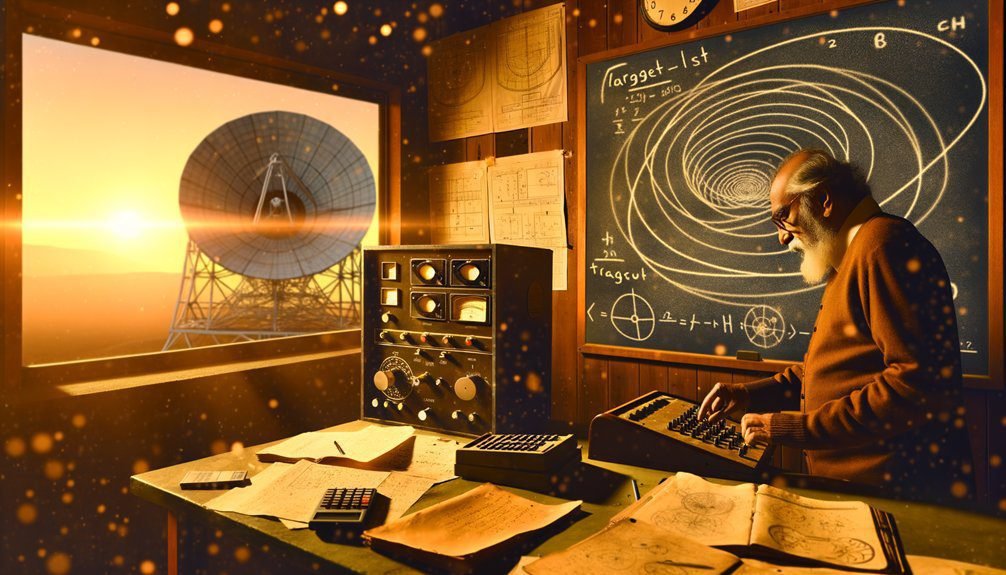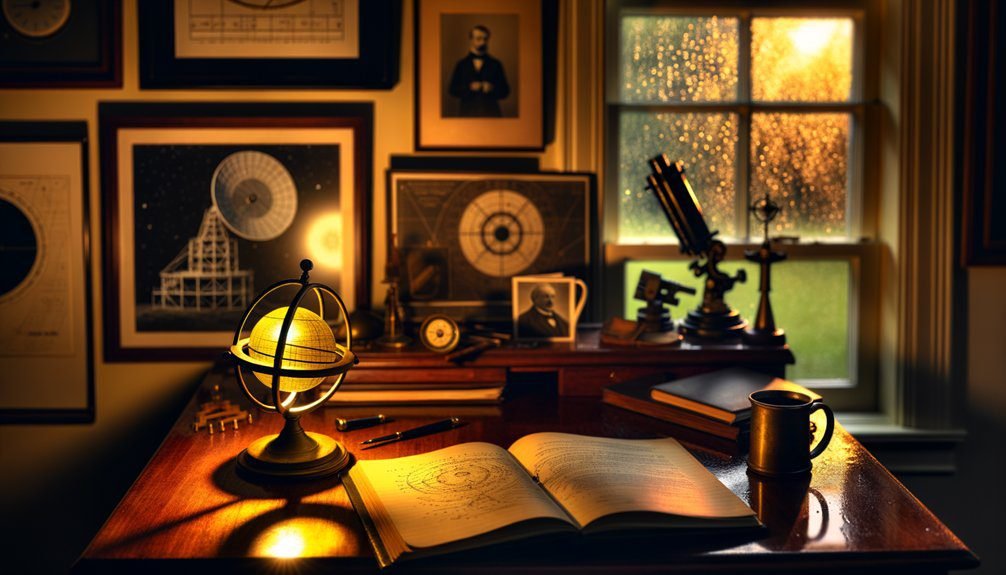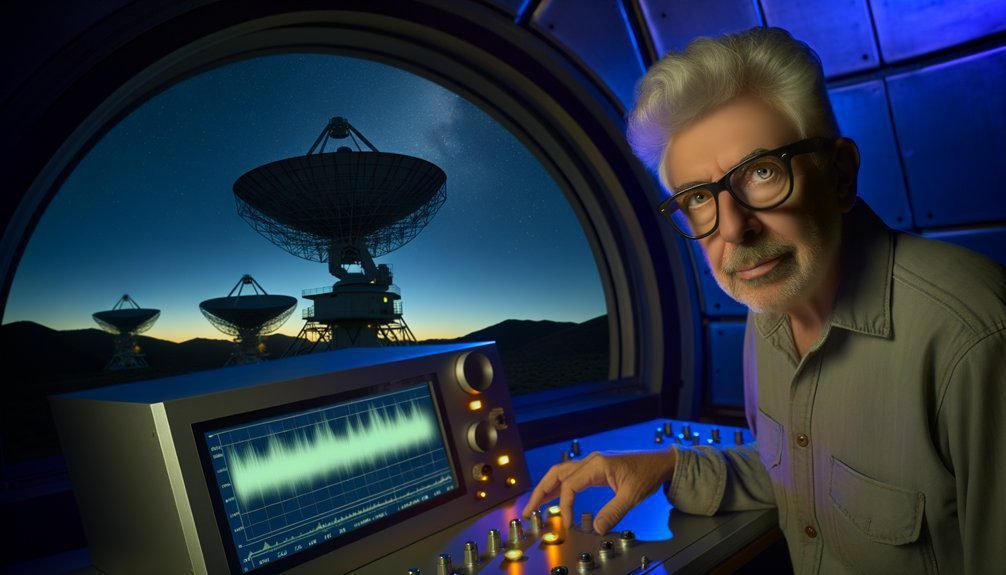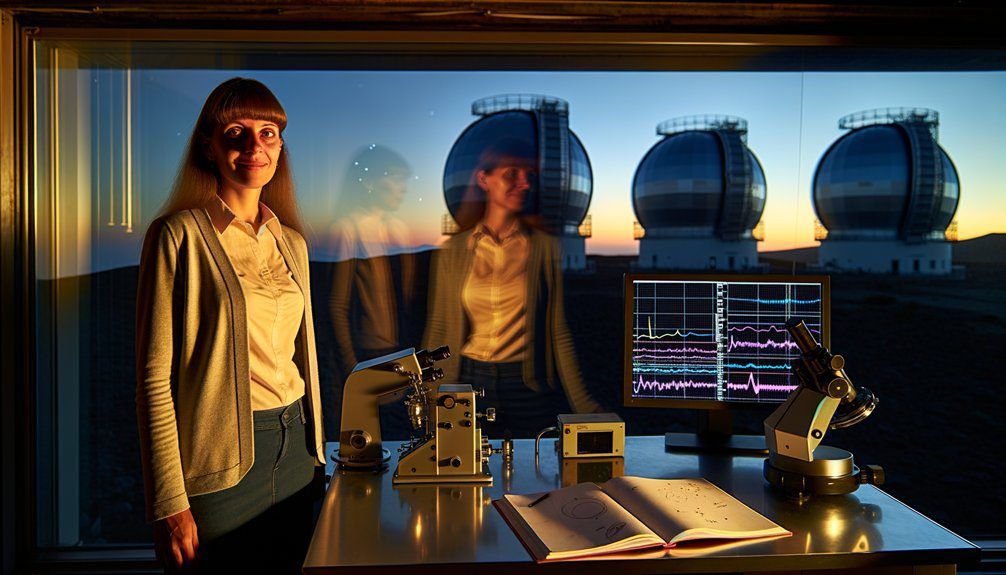You’ll meet engineers and theorists who turned SETI into measurable science: Frank Drake (Drake Equation, survey design), Cocconi & Morrison (radio‑SETI theory, hydrogen‑line targeting), Bernard Oliver (signal processing, instrumentation), Jill Tarter (observational strategy, advocacy), Carl Sagan (public and policy frameworks), Seth Shostak (search tactics, outreach), Jocelyn Bell Burnell (precision time‑series methods) and Sara Seager (exoplanet atmospheres, biosignature frameworks); keep going to see how their methods and tools fit together.
Key Takeaways
- Frank Drake pioneered quantitative SETI, created the Drake Equation, and designed early targeted radio search methodologies.
- Giuseppe Cocconi and Philip Morrison founded radio SETI theory, proposing the 21-cm hydrogen line as a universal search frequency.
- Jill Tarter institutionalized SETI research, optimizing observational strategies and advocating for dedicated search programs.
- Bernard Oliver developed signal-processing techniques for detecting weak narrowband extraterrestrial transmissions and false-alarm control.
- Sara Seager advanced exoplanet atmospheric characterization and biosignature detection, connecting astrobiology to SETI observation strategies.
Frank Drake — Pioneer of Modern SETI and the Drake Equation

Though you might think of SETI as a recent, data-driven enterprise, Frank Drake’s work in the early 1960s established its quantitative and observational foundation. You’ll find his formulation—the Drake Equation—serves as a parametric framework to decompose the probability of detectable civilizations into measurable factors: star formation rates, planetary occurrence, fraction developing life, and communicative lifetimes. You’ll use that framework to prioritize observations and to quantify uncertainty ranges for hypothesis testing. Drake also implemented practical SETI Methods: targeted radio searches, receiver sensitivity analysis, and systematic survey design that formalized signal-to-noise requirements and false-positive mitigation. When planning experiments, you’ll apply his approach to allocate telescope time, choose frequency bands, and set integration times consistent with expected signal flux densities. His work converts speculative questions into operational metrics, enabling iterative refinement as exoplanet demographics and biosignature models improve. You’ll thus treat Drake’s contributions as the analytic backbone for both strategy and instrument specification in contemporary SETI.
Jill Tarter — Champion for SETI Research and Public Outreach
Because effective public engagement shapes funding, policy, and the social license for long-term searches, Jill Tarter combined rigorous scientific leadership with sustained outreach to institutionalize SETI as a legitimate research program. You’ll recognize Tarter’s Vision in her methodical synthesis of engineering constraints, signal-processing algorithms, and observational strategy to define credible search parameters. You’re expected to evaluate trade-offs she highlighted: bandwidth versus sensitivity, targeted versus survey modes, and false-positive mitigation. You’ll also see how Public Engagement was operationalized — translating technical uncertainty into accessible metrics for funders and the public without compromising methodological transparency. When you study her career, note the institutional outcomes: dedicated research groups, standardized data formats, and curricular integration of astrobiology and radio astronomy. You can apply her model: pair rigorous peer-reviewed science with proactive communication that quantifies uncertainty and articulates societal value. That dual approach altered the probability calculus for long-term support and embedded SETI within mainstream scientific infrastructures.
Carl Sagan — Popularizer of Planetary Science and SETI Advocate

Jill Tarter’s blend of technical rigor and public articulation set a template that others in the field amplified in different ways; Carl Sagan took that template and wielded a distinctly rhetorical and cross-disciplinary toolkit to expand SETI’s cultural reach. You’ll find Sagan’s Legacy in how he translated complex planetary science and astrobiology into testable frameworks and public narratives that justified funding and interdisciplinary collaboration. His Planetary Advocacy connected exploration, habitability metrics, and the search for intelligence into coherent policy and outreach arguments. You’ll appreciate the precision of his probabilistic reasoning about habitability and the methodological insistence on empirical constraints.
| Role | Contribution | Impact |
|---|---|---|
| Communicator | Books, TV | Public engagement |
| Theorist | Habitability metrics | Research agendas |
| Advocate | Policy testimony | Funding support |
| Integrator | Cross-discipline framing | Institutional adoption |
| Critic | Skeptical rigor | Scientific standards |
Philip Morrison — Early Radio Astronomer and SETI Proponent
When you trace SETI’s roots in radio astronomy, Philip Morrison stands out for bringing rigorous physics and clear experimental strategy to the question of extraterrestrial intelligence; trained as a nuclear physicist, he repurposed spectral and signal-analysis techniques to define practical search parameters and advocate for radio surveys. You’ll recognize Morrison’s contributions in methods that prioritize narrowband, high signal-to-noise detection and in proposals that translated theoretical detectability into instrument specifications. In early radio work he emphasized quantitative thresholds, bandwidth selection, and Doppler considerations, which you can map directly onto modern receiver design. His SETI advocacy combined technical papers, coordination of observing programs, and mentorship that fostered scientific collaboration across institutions. You’ll also see deliberate public engagement: he communicated probabilistic reasoning and experimental limits without overstating claims, shaping both scientific and popular expectations. Overall, his approach turned speculative discussion into testable hypotheses and reproducible observing protocols that continue to influence SETI methodology.
Giuseppe Cocconi and Philip Morrison — Founders of Radio SETI Theory

Although their 1959 paper was brief, Giuseppe Cocconi and Philip Morrison established the technical foundation for radio SETI by applying physics-based signal detection concepts to the practical problem of interstellar communication. You’ll see Cocconi’s vision in the choice of the 21-centimeter hydrogen line as a universal carrier frequency, grounded in astrophysical constants that maximize detectability across light-years. Morrison’s contributions complemented that choice with quantitative estimates: required transmitter power, signal-to-noise ratios, and detection bandwidths derived from radiometry and information theory. You’ll appreciate their methodological clarity: they reduced an astronomical search to measurable parameters—flux density thresholds, antenna gain, integration time—and proposed realistic observational strategies. Their framework lets you translate theoretical likelihoods into instrument specifications and search algorithms. By framing SETI as an engineering problem constrained by astrophysical realities, they made subsequent experimental design and statistical assessment rigorous rather than speculative, enabling reproducible planning for directed and all-sky radio searches.
Bernard Oliver — Instrumentation Innovator for SETI
You’ll examine how Bernard Oliver translated theoretical search concepts into practical radio telescope engineering, optimizing antenna design and receiver chains for wideband surveillance. You’ll also assess his breakthroughs in real-time signal processing architectures and digital filtering that increased sensitivity to narrowband and transient signatures. Together these topics show how instrumentation advances raised SETI’s detection capability from concept to operational systems.
Radio Telescope Engineering
If you’re examining the hardware that made modern SETI feasible, Bernard Oliver’s contributions to radio telescope engineering deserve immediate attention. You’ll appreciate his focus on antenna design and radio frequency selection to minimize signal interference and maximize sensitivity. He advanced telescope calibration protocols and observation techniques, linking meticulous equipment maintenance with reproducible data analysis. His work pushed technology advancements that required consistent research funding and fostered scientific collaboration across institutions.
- Precise antenna design to control beam patterns and reduce sidelobes.
- Calibration and maintenance regimes ensuring stable gain and phase for long integrations.
- Integration of observation techniques with funding-driven technology upgrades and shared engineering standards.
You’ll see practical, reproducible engineering supporting ambitious SETI goals.
Signal Processing Pioneer
While advancing beyond antenna hardware, Bernard Oliver pioneered signal processing approaches that made weak, narrowband extraterrestrial signals practically detectable by optimizing digital filtering, spectral estimation, and real-time detection pipelines. You’ll appreciate his emphasis on algorithmic efficiency: matched filtering, coherent integration, and adaptive noise cancellation were engineered to maximize signal detection probability under constrained compute and dynamic radio-frequency interference. Oliver framed requirements for quantization, sampling rates, and Fourier-transform implementations that preserved signal-to-noise ratio across processing stages. He also established procedures for data analysis validation, false-alarm control, and pipeline calibration, so outputs were statistically interpretable. When you design or evaluate SETI instrumentation, his methods guide trade-offs between sensitivity, computational load, and robustness to nonstationary noise, enabling reproducible, scalable searches for technosignatures.
Seth Shostak — Longtime SETI Institute Astronomer and Communicator

Seth Shostak, a senior astronomer at the SETI Institute, has spent decades combining radio astronomy, public communication, and programmatic leadership to shape modern searches for extraterrestrial intelligence. You’ll find his work emphasizes rigorous signal validation, instrument optimization, and outreach to translate technical results into public understanding. Seth Shostak’s contributions include algorithm evaluation, survey design, and communicating probabilistic assessments of detectability — he frames expectations scientifically while avoiding sensationalism.
- Algorithmic and instrumentation improvements: quantitative metrics for sensitivity and false-alarm mitigation.
- Programmatic strategy: prioritization of targets and allocation of observing resources based on detection likelihood models.
- Public communication: succinct translation of technical findings, risk of misinterpretation, and statistical context for non-experts.
You’ll appreciate the balance he strikes between technical rigor and accessibility; his analyses are reproducible, assumptions explicit, and implications for search design clearly articulated so practitioners and informed lay readers can assess SETI progress.
Jocelyn Bell Burnell — Pulsar Discoverer and Advocate for Astrobiology
Discovery-minded and exacting, Jocelyn Bell Burnell is best known for her 1967 detection of pulsars—rapidly pulsing radio sources whose regularity and spectral properties revealed a new class of neutron stars—and for translating that skillset into advocacy for astrobiology and diversity in the physical sciences. You’ll recognize her approach: rigorous signal processing, meticulous time-series analysis, and an emphasis on reproducible instrumentation design. Her pulsar discovery exemplifies hypothesis-driven observation coupled with openness to serendipity, a model you can apply to SETI signal validation. In later work she advanced astrobiology advocacy by arguing for interdisciplinary frameworks that link radio astronomy, planetary science, and biology, and by promoting equitable access to facilities and data. You should note her influence on standards for candidate-event verification, archival data reuse, and mentorship practices that broaden participation in technical disciplines. Her career shows how precise observational technique and structural reform together strengthen the scientific search for life beyond Earth.
Sara Seager — Exoplanet Atmospheres and Biosignature Detection Expert

Building on the rigorous observational and verification practices exemplified by Jocelyn Bell Burnell, Sara Seager has shaped the theoretical and observational framework for detecting atmospheric signatures of exoplanets and evaluating biosignature plausibility. You’ll find her work blends radiative transfer, retrieval algorithms, and instrument design to make exoplanet detection quantitative and repeatable. Her models define how molecular absorption, scattering, and thermal structure map to observables, and she’s advanced criteria to discriminate false positives in biosignature analysis.
- Atmospheric retrieval: formulation of inverse problems that infer composition and temperature profiles from spectra, with uncertainty quantification.
- Instrument-constrained modeling: translating telescope specifications into detectable signal thresholds for transit and direct-imaging modes.
- Biosignature frameworks: establishing contextual tests and non-biological hypotheses to robustly assess claims of life.
You’ll appreciate how these contributions convert raw spectral data into probabilistic statements about habitability, enabling rigorous SETI-adjacent searches that prioritize reproducibility and statistical significance.
Frequently Asked Questions
How Can I Join or Support SETI Research as a Non-Scientist?
Like a bridge spanning data to discovery, you can join or support SETI by engaging in public engagement programs and volunteer opportunities: contribute via citizen-science platforms (e.g., signal classification), donate to research funds, attend workshops, or help with outreach and fundraising. You’ll collaborate with scientists, follow protocols, learn technical tools, and document findings. Expect structured tasks, clear metrics, and supervised access so your efforts yield reproducible, scientifically useful results.
What Are Seti’s Current Funding Sources and Budgets?
SETI’s current funding primarily comes from private foundations, individual donors, and institutional grants; you’ll see smaller government or university contributions. SETI funding is allocated across instrumentation, operations, data analysis, and outreach; budget allocation prioritizes telescope time, signal processing hardware, and software development. You’ll find annual budgets varying widely between projects, typically ranging from hundreds of thousands to a few million dollars, depending on scope and donor commitments.
Have Any Credible Extraterrestrial Signals Ever Been Confirmed?
No — you haven’t seen any extraterrestrial signals gain credible confirmation. Like searching for a needle in cosmic haystacks, SETI detections (e.g., the 1977 “Wow!”) provoked careful analysis but lacked reproducible, instrument-verified evidence. You’ll find transient anomalies, anthropogenic interference, and statistical fluctuations; rigorous protocols demand repeatability, multi-site verification, and detailed metadata before a credible confirmation is declared. Current consensus remains null, pending incontrovertible, independently replicated data.
How Does SETI Coordinate Internationally During a Candidate Detection?
You coordinate internationally via predefined protocols: observatories alert networks, share raw data and metadata, and invoke candidate verification procedures. You’ll follow standardized formats (VOEvent, FITS), timestamped logs, and simultaneous follow-up schedules to rule out local interference. Trusted labs run independent analyses, cross-check hardware and software, and report results to governance bodies. Communication stays transparent, rapid, and logged so attribution and reproducibility are preserved throughout the verification campaign.
What Ethical Rules Govern Contacting an Extraterrestrial Intelligence?
You follow established contact protocols and ethical considerations that prioritize global consultation, transparency, and non-aggression. Procedures call for verifying signals, notifying international bodies, and deferring transmission decisions to coordinated scientific and political fora. Ethical rules emphasize avoiding unilateral messaging, protecting biosafety, respecting cultural diversity, and evaluating long-term risks and benefits. You’d weigh consent, responsibility, and reversibility, documenting decisions technically and engaging legal, scientific, and public stakeholders before any reply.